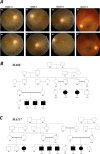Confirmation of the Role of DHX38 in the Etiology of Early-Onset Retinitis Pigmentosa
- PMID: 30208423
- PMCID: PMC6133250
- DOI: 10.1167/iovs.18-23849
Confirmation of the Role of DHX38 in the Etiology of Early-Onset Retinitis Pigmentosa
Abstract
Purpose: Retinitis pigmentosa (RP) is a genetically heterogeneous trait with autosomal-recessive (ar) inheritance underlying 50% of genetic disease cases. Sixty-one arRP genes have been identified, and recently, DHX38 has been reported as a potential candidate gene for arRP with only a single family reported with a variant of unknown significance. We identified a missense variant in DHX38 that co-segregates with the arRP phenotype in two Pakistani families confirming the involvement of DHX38 in the etiology of early-onset RP.
Methods: Exome sequencing was performed using two DNA samples from affected members of Pakistani families (MA88 and MA157) with early onset arRP. Sanger sequencing of DNA samples from all family members confirmed the segregation of candidate variant within both families.
Results: A novel missense DHX38 variant c.971G>A; p.(Arg324Gln) was identified which segregates with the arRP phenotype and yielded a logarithm of the odds (LOD) score of 5.0 and 4.3 for families MA88 and MA157, respectively. This variant is predicted to be conserved and deleterious by several bioinformatics tools.
Conclusions: We identified a second deleterious DHX38 variant that segregates with arRP in two families, providing additional evidence that DHX38 is involved in RP etiology. DHX38 encodes for pre-mRNA splicing factor PRP16, which is important in catalyzing pre-mRNA splicing.
Figures

References
-
- Ajmal M, Khan MI, Neveling K, et al. A missense mutation in the splicing factor gene DHX38 is associated with early-onset retinitis pigmentosa with macular coloboma. J Med Genet. 2014;51:444–448. - PubMed
-
- Yanamandra G, Lee ML. Isolation and characterization of human DNA in agarose block. Gene Anal Tech. 1989;6:71–74. - PubMed
Publication types
MeSH terms
Substances
Grants and funding
LinkOut - more resources
Full Text Sources
Other Literature Sources
Molecular Biology Databases
Research Materials

